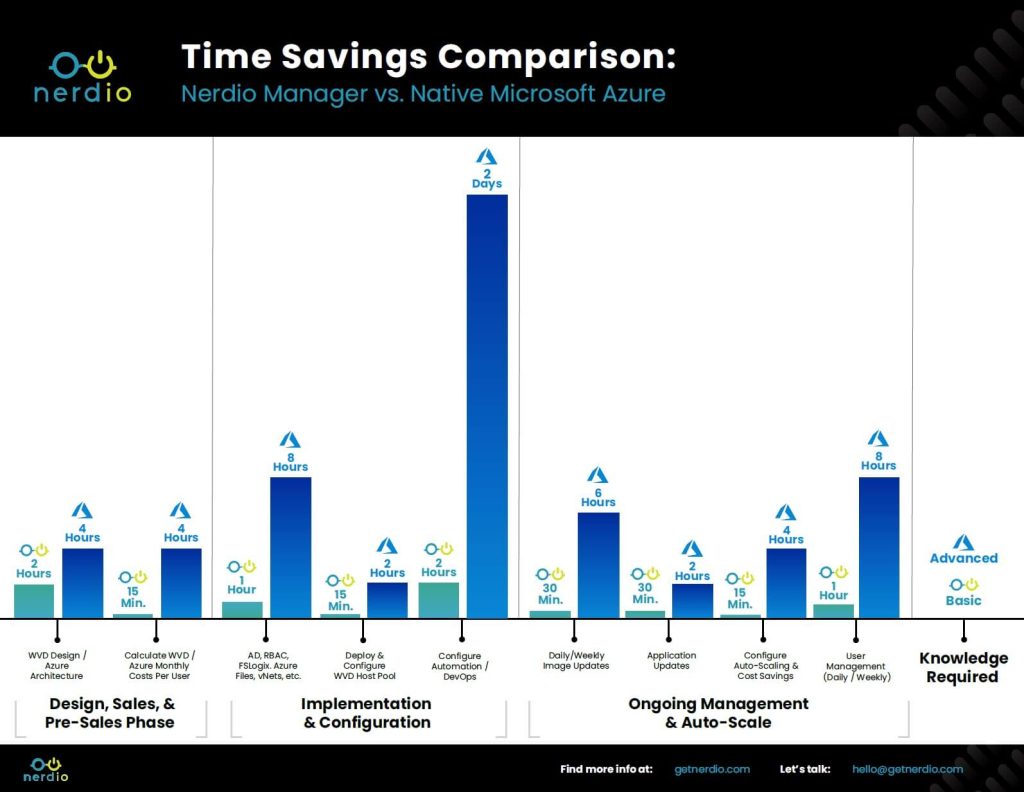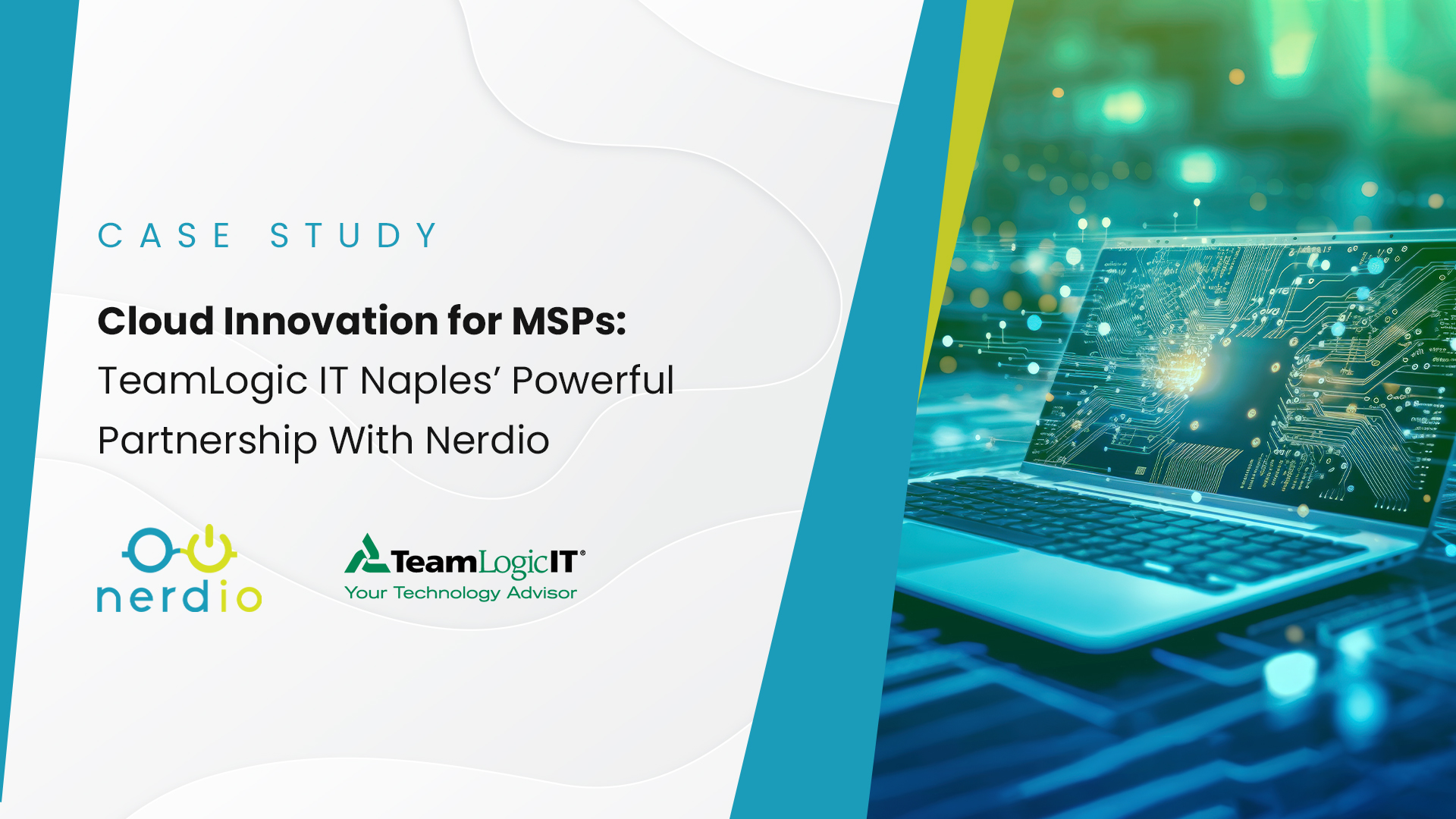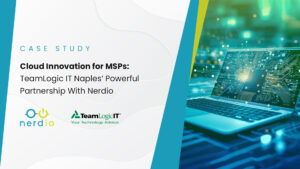Throughout the last year, I have spoken to more than 250 different partners and customers. Not only has it been a lot of fun, but it has also been very educational. As a result, I have worked with many smart and fun people. I learned a lot, which also enabled me to view dozens, if not hundreds, of different (Windows) Virtual Desktop environments.
Not just the ones built and managed with Nerdio, no; most were already in place and being used for test or production purposes. However, almost all of these organizations had something in common: they were all looking for a better, easier, and more efficient way to manage and optimize their Azure and WVD environments, which inevitably led them to Nerdio.
75% of the companies I talk to each week already have an existing WVD deployment in place. It is no coincidence that they end up with Nerdio, as they all seem to have the same challenges – see “The (business) risk” section a bit further down as well:
- The lack of Azure knowledge within the company. Azure can be overwhelming and WVD comes with a steep learning curve
- Lots of manual (PowerShell) tasks are involved
- Getting things automated is a tough task, if at all possible. It takes up a lot of time and it’s definitely not for everybody.
- Once automation is in place, it can be hard to maintain and update
- Companies worry about knowledge leaving their company
- Ongoing user management is a challenge
- Management of applications / images is a cumbersome process and takes too long
- Monitoring is hard to set up, alerting is not possible or is limited
- Azure and WVD can be (very) expensive if you do not know what to look out for and lack proper tooling to help you with that. In other words, how to save time and money and take full advantage of all that Cloud has to offer
- Big feature gap. Most companies think WVD is not production-ready and misses enterprise-grade features and functionalities
These are all valid concerns and challenges that we run into (and solve) daily. In short, getting things set up is “just” step one; it’s the other 80-90% they worry about.
Automation
Automation, in different forms and shapes, is great and I highly encourage all technically orientated IT professionals to get acquainted in some form, or even deep dive right into it. However, you also need to be realistic and look at it from a business perspective.
The companies who do have this “down” often lack time to keep everything updated and running smoothly. They are too busy dealing with the day-to-day operations and putting out fires, as they say. While this is nothing new, it’s also something that won’t change overnight, as it’s in the nature of our profession. While this is accepted, or acceptable to most, it also poses a problem or a challenge, at the very least – unfortunately, you can only spend your time once.
Getting real hands on experience also takes a lot of time. As highlighted above, automation and DevOps can be tricky to maintain and it’s definitely not for everybody. If it were easy, everybody would do it and I can tell you from personal experience, that is definitely not the case.
Tech Savvy
When it comes to IT professionals, you roughly have two kinds; the tech-savvy “I really like to dig in” kind of sysadmin (at Nerdio we have a lot of those), and the more all-round and laid-back “I don’t want to spend my free time getting to know (new) technology” kind of sysadmin, which is perfectly fine and makes a lot of sense.
The latter doesn’t mind digging in a bit and staying current in general but has no interest in going all in all the time. He or she likes it when things are automated for them. They like to work with “to the point” solutions and easy-to-use graphical user interfaces – that being WVD or any other type of service/technology, like VDI in the past, for example.
They’ll keep their certifications up to date but won’t become an automation, PowerShell, or scripting guru anytime soon. It’s a job they love, it gives them fulfillment, but that’s it. This will apply to 80% of the people in IT, give or take.
The tech-savvy sysadmin likes to deep-dive whenever he or she can. They’ll probably blog about it, help others on various forums and social media, contribute to community programs, and so on – work becomes a hobby, or vice versa, in many cases. It isn’t for everyone; far from it, even. And that’s OK, too.
Risky Business
Given the above, you could state that this also imposes a risk for companies; to those who are using WVD/Azure or are thinking about doing so, and those who do not.
Most companies will have a couple of tech-savvy senior system administrators employed. Up to a certain point they will be able to automate and streamline deployments, script image updates, use various kinds of DevOps methodologies, and so on.
They will have it running as smoothly as possible, they will handle all code, templates, updates, daily management tasks – you name it.
However, what happens when something needs to be updated or breaks, and no one is available for some reason? Maybe they are “putting out fires” and are needed somewhere else? Perhaps they are spending time with friends and family and are not reachable? What if they leave your company, or even worse; they become ill for a longer period of time (let’s hope not)?
The saying “putting all your eggs into one basket” comes to mind.
Educating and training other employees isn’t that straightforward. I mean, doing your “job” because you are asked or told to is something completely different (even though you may still love your job) than when it’s born from passion, as part of your day job, especially if it doesn’t come naturally or from within.
What about hiring in the expertise? Sure, but they won’t know your company the way you or your (former) employee(s) do/did, they are often much more expensive, and by default, they will leave as well. A vicious cycle.
Managing IT resources, WVD or otherwise, should not require “special” skills or take a longer period to learn, I think most companies will agree. If anything, it should reduce your time to market and help make you (more) money, free up time to put out those fires, and/or come up with a more permanent, future-proof solution – preferably by taking advantage of cutting-edge technology supercharging your Azure/WVD deployments.
The goal should be to relieve individuals from unneeded stressful situations, spread the workload evenly across your team, do more with less, and save hours per week on common day-to-day management tasks, creating room for other types (more interesting, fun, or important) of tasks.
Nerdio
At Nerdio, we are all about giving you back some of your valuable time while saving on WVD/Azure compute and storage resources, big time.
In fact, throughout the last couple of months, we have been spending quite some time talking to customers and partners to get a good perspective on how we help save companies time and thus, money – the proof is in the pudding, as they say.
I won’t go into any technical details at this point and let the graph speak for itself. Of course, these numbers are debatable, and might differ per company, individual, etc. It could be that even more time is saved, or perhaps a bit less in some cases. The point is, by using Nerdio, the life of a/your WVD/Azure admin will become much more efficient and less stressful.

Because of our intuitive approach, we enable just about anyone within your company who has basic Azure knowledge to work with, built, cost optimize, and manage Windows Virtual Desktop environments on Microsoft Azure on a daily basis.
As always, don’t just take my (biased) word for it. Instead, try it for yourself. Need some help in setting things up? Let us know and we’ll jump on a call. Do you have any other questions? No problem, we are here to help.
Thank you for reading, talk soon!
Bas van Kaam
Nerdio Field CTO, EMEA










